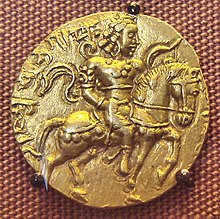| Chandragupta II | |
|---|---|
| Sun of Valour The Holy one King of kings God King Lord of the Guptas The exalted Lord | |
 | |
| Gupta emperor | |
| Reign | c. 375 or 380 – c. 415 CE (35-40 year) |
| Predecessor | Samudragupta, possibly Ramagupta |
| Successor | Kumaragupta I |
| Born | Unknown Pataliputra, Gupta Empire (Present day Bihar, India) |
| Died | c. 415 CE Pataliputra, Gupta Empire (Present day Bihar, India) |
| Spouse | Dhruvadevi, Kuberanaga |
| Issue | |
| Dynasty | Gupta |
| Father | Samudragupta |
| Mother | Dattadevi |
| Religion | Hinduism[2] |
| Military career | |
| Battles / wars |
|
Chandragupta II (r.c. 375-415), also known by his title Vikramaditya, as well as Chandragupta Vikramaditya, was the third ruler of the Gupta Empire in India. Modern scholars generally identify him with King Chandra of the Delhi iron pillar inscription.
Chandragupta II continued the expansionist policy of his father Samudragupta through military conquests and marital alliances. Historical evidence attests to his remarkable victories, which include the defeat of the Sassanids,[3] the conquest of the Western Kshatrapas and the vassalization of the Hunas. Under the reign of Chandragupta II, the Gupta Empire reached its zenith, directly controlling a vast territory which stretched from the Oxus River[4] in the west to the Bengal region in the east, and from the foothills of the Himalayas in the north to the Narmada River in the south. Chandragupta II expanded his influence and indirectly ruled over the Kuntala region of Karnataka through a marriage alliance with Kadambas, and during his daughter Prabhavatigupta’s 20 years long regency, he effectively integrated the Vakataka kingdom into the Gupta Empire.[5][6][7]
Chandragupta II was a devout Vaishnav but tolerated other faiths as well. The Chinese pilgrim Faxian, who visited India during his reign, suggests that he ruled over a peaceful and prosperous kingdom. The legendary figure of Vikramaditya is probably based on Chandragupta II (among other kings), and the noted Sanskrit poet Kalidasa may have been his court poet. The cave shrines at Udayagiri were also built during his rule.
- ^ *1910,0403.26
- ^ Doniger, Wendy (2009). The Hindus: An Alternative History. p. 379. ISBN 9781594202056. Retrieved 24 September 2022.
- ^ Prakash, Buddha (1962). Studies in Indian History and Civilization. Shiva Lal Agarwala.
- ^ Agrawal, Ashvini (1989). Rise and Fall of the Imperial Guptas. Motilal Banarsidass Publ. p. 240 & 264. ISBN 978-81-208-0592-7.
- ^ Raychaudhuri, Hem Channdra (1923). Political history of ancient India, from the accession of Parikshit to the extinction of the Gupta dynasty. Robarts - University of Toronto. Calcutta, Univ. of Calcutta. pp. 282–288.
- ^ Annual Report Of Mysore 1886 To 1903.
- ^ Hermann Kulke & Dietmar Rothermund 2004, p. 91.